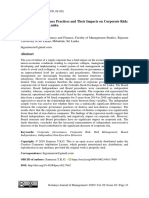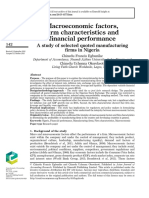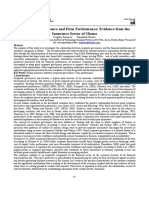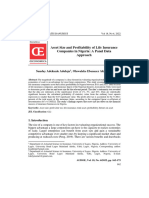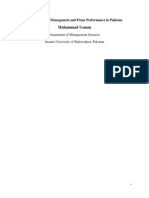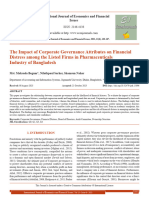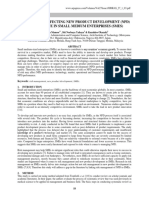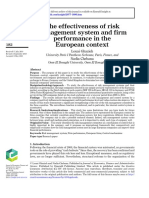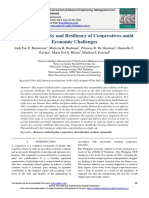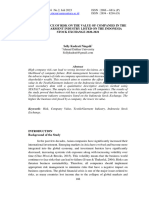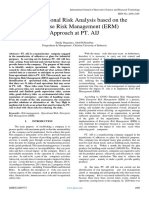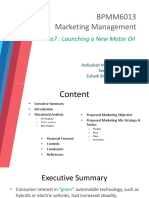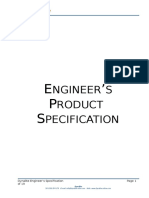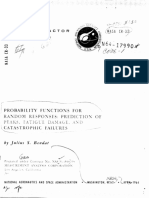Professional Documents
Culture Documents
Internal Control and Risk Management in Oil and Gas Companies in Nigeria
Internal Control and Risk Management in Oil and Gas Companies in Nigeria
Copyright
Available Formats
Share this document
Did you find this document useful?
Is this content inappropriate?
Report this DocumentCopyright:
Available Formats
Internal Control and Risk Management in Oil and Gas Companies in Nigeria
Internal Control and Risk Management in Oil and Gas Companies in Nigeria
Copyright:
Available Formats
Volume 8, Issue 4, April 2023 International Journal of Innovative Science and Research Technology
ISSN No:-2456-2165
Internal Control and Risk Management in
Oil and Gas Companies in Nigeria
Adesina Biola Hammed, Kolawole Oyegoke, Olalere Mayowa David, Olorundare Kehinde Joseph
Abstract:- Over the years, Nigerian oil and gas greatly affected. (Munir, 2018). The rules even allow
companies have faced significant mismanagement risks national organizations to allocate their resources using the
and problems. These failures include management issues same risk management that drives the company's revenue
for oil and gas companies, capital requirements issues, (Mulyono, Asmawi & Nuriah, 2018).
idiosyncratic financing issues, and bankruptcy for oil
and gas companies. This study explores the impact of In South Africa, oil and gas companies faced similar
internal controls on risk management in Nigerian oil and challenges in developing an effective approach to risk
gas companies. Research approach was adopted in this management. Oil and gas companies are exposed to
study. Topics of this study include 100 internal control uncertainty that occurs in many organizations (Akwaa-
officers, executives in oil and gas finance companies, Sekyi& Moreno, 2017). Therefore, most of these companies
compliance officers, senior and middle managers, and are top level in credit management, business, financial and
internal audits of selected oil and gas companies in Lagos financial risk.
State, Nigeria.Analyze data using descriptive and
inferential statistics. This study shows that internal However, in order to balance the situation in most
control has no significant effect on the credit risk organizations with various risks, it is important to
management of Nigerian oil and gas companies (p>0.05). understand all the risks involved and to use effective
This study shows that internal control has a significant methods for internal control and management to prevent or
impact (p>0.05) on the commercial risk management of mitigate the impact of these hazardous situations. they
become (Zubarev, Glukhova & Makovetsky, 2016).
Nigerian oil and gas companies.This study shows that
Therefore, optimizing the benefits that an enterprise-wide
internal control has a significant impact (p < 0.05) on the
financial risk management of Nigerian oil and gas risk management approach brings to organizations is
companies. The study concluded that internal control critical. Risk management is a valuable management tool
affects risk management in Nigerian oil and gas that contributes positively to the success of the company by
companies. A regular review of the internal management reducing and optimizing negative consequences. , choose
of oil and gas companies is recommended to ensure appropriate risk management techniques to address the risk
compliance with guidelines set out in international best of loss, and implement and maintain risk management
practice to minimize fraud, fraud and error. systems for all organisations. In general, effective internal
control procedures allow the company to mitigate risk and
Keywords:- Risk Management, Internal Control, Credit Risk prepare to survive unexpected problems. The fact that good
Management, Market Risk Management, Financial Risk internal controls are in the best interests of management,
Management. shareholders and other stakeholders is sometimes
jeopardized when new regulations and compliance costs are
I. INTRODUCTION imposed on companies due to poor performance.
Recently, risk management has become an important Implementing effective internal controls allows
phenomenon for businesses and the way they interact with organizations to invest in opportunities while reducing risks,
them to avoid impacting the safety of the facility business. which can save time and money and facilitate productivity
Traditionally, risk management has focused on internal and and retention (Mendoza and Rivera, 2017). Peter (2016) also
external risks affecting all international organizations, stated that the importance of implementing internal controls
whether established or established. Both developed and such as employee compliance, fraud investigation and
developing countries face financial risks that can lead to loss financial reporting in the organization is unacceptable in
of investment or business risks (Olivier, 2018). This is more financial institutions. A good internal control system can
common because companies in developing countries such as help the organization achieve its objectives. Currently, most
the United States and the United Kingdom are concerned organizations in many countries are evaluating and
about financial losses from risks affecting the economy and implementing internal control provided by COSO. Due to
growth (Zubarev, Glukhova and Makovetsky, 2016). the above-mentioned problems of risk management in
business organizations, this study focuses on investigating
Australian organizations are exposed to financial risks the relationship between internal control and risk
due to a variety of macroeconomic factors, changes in management. 444 1.
market interest rates and the prospect of business or
economic growth. The main impact of poor risk management is how oil
and gas company management can improve supply in cost,
There are also other financial risks when they decide time and quality decisions. This is because Nigerian oil and
to earn their income and solvency in the organization, which gas companies have had low oil risk in the past, which has
they think they can fix in the months after the event and be affected the government's allocation of funds to state
IJISRT23APR1003 www.ijisrt.com 2518
Volume 8, Issue 4, April 2023 International Journal of Innovative Science and Research Technology
ISSN No:-2456-2165
governments. The lack of risk in the oil and gas industry has other business people, other than Oil companies that make a
led to a lack of guidance to develop and achieve better loud noise about business discipline. gas. company.
management goals that include the balance of knowledge
skills and involved members. This represents the challenge This research is very important to the academic
Nigeria faces when trying to reconcile all kinds of risks and community.
conflicts in the oil industry through the concept of internal
governance, especially when seeking day-to-day The academic cycle has been ahead of research on the
management (Angela, 2016). Maybe that's why the oil and impact of internal control on risk management. This study
gas industry has a bad model. will contribute to the domestic and foreign literature on
internal control and risk management by focusing on recent
For example, there are credit risk, income risk, long- years rather than previous years. Finally, this work can
term business risk, risk and financial risk in petroleum equally serve as a reference for students wishing to do more
products interaction. These risks can lead to one way or research on this famous school and others.
another ineffectiveness in the oil and gas industry due to the
organization's failure to fulfill its responsibilities E. Organization of the next chapter
(Fapohunda& Beth, 2020). Chapter 2 presents the data analysis, while Chapter 3
presents the research methodology.
A. Research Objectives and Objectives
The main purpose of this study is to examine the impact Chapter 4 presents the data analysis, conclusions and
of internal control on risk management and special purpose discussion, and finally Chapter 5 presents the summary,
oil in Nigerian oil companies: conclusions and recommendations.
Analysis of the impact of internal controls on the credit II. DATA ANALYSIS
risk management of Nigerian oil and gas companies.
Determining the Impact of Internal Control on Business A. Internal Control and Credit Risk Management
Performance of Nigerian Oil and Gas Companies. In a recent study, Alzoubi (2017) examined the
one. Impact of Internal Control Design on Financial determinants of compliance by employees and management
Management of Nigeria Oil and Gas Corporation. on respect, fraud, compliance, financial reporting, and credit
risk management. Using panel data analysis, the study found
B. Research Question an interaction between employee and police compliance,
This study will answer the following research questions; fraud investigation, regulatory compliance, corporate
What is the impact of internal control on the risk reporting, and risk management. The study also showed that
management of Nigerian oil and gas companies? internal control (compliance and employee management,
Does Internal Control Affect Business Risk Management fraud investigation, management control, financial reporting
in Nigerian Oil and Gas Companies? of the organization) contributes to the risk management
(credit risk management) process of oil and gas companies.
C. Scope of study
The subject of this study covers internal control According to the results, 75 percent of insiders said
personnel, financial auditors, compliance personnel, middle identifying fraud risk helped them complete their risk
and level personnel, pressure and internal control personnel management tasks, indicating that management's Internal
of oil and gas companies in Lagos State, Nigeria. 2019, auditors can advise employees and other audit groups on
Nigerian business groups have a total of twenty-four (24) risk management. It is designed to combat financial fraud.
multinational oil and gas companies listed. Five of these The study concluded that the use of internal resources by
companies, known as the Big Five (ExxonMobil, Shell, employees should be improved and there should be
Chevron, Agip, and Total), were used in this study, with the monitoring and internal control for all kinds of risks in all
majority of investments being 95%. A total of 20 management organizations.
questionnaires, 100 forms in total, were distributed.
Akinwumi, Michael, and Raymond (2017) conducted
D. Research Findings research on employee compliance and management, fraud
This research is based on the country (Nigeria) and analysis, regulatory compliance, financial reporting, and
international community - stakeholders, business owners, credit risk in organizations. The results of the study using
entrepreneurs etc. The chairman improves the local risk Pearson's correlation coefficient showed a positive
management system, beneficial for many national and relationship between employee compliance and law
foreign oil and gas companies and expanding their enforcement, fraud detection incentive, regulatory control,
operations. Business information. implement internal financial reporting and credit risk management. Their
controls and improve their performance and delivery in the findings also show the relationship between risk
country. This study will make organizations aware of the management processes (risk management, risk management
importance of providing the necessary information to and financial risk management) and bank departments,
improve performance in the Petroleum industry. suggesting that companies should adopt the best available
risk management model and use the risk management
After many criticisms, risk management, business process. increase return on equity and reduce cost of loss.
failures and other business failures in Nigerian MNCs, this
study has implications for businesses, especially oil and all
IJISRT23APR1003 www.ijisrt.com 2519
Volume 8, Issue 4, April 2023 International Journal of Innovative Science and Research Technology
ISSN No:-2456-2165
The study concluded that oil and gas companies should C. Internal Control and Financial Risk
review and redesign their risk management strategies to Abbas and Abu (2019) examines the impact of reporting
improve shareholder performance and improve asset on employee and management compliance, fraud detection,
utilization. regulatory controls, and financial aspects of financial risk
Muriithi and Waweru (2017) examine the impact of management in the Nigerian business economy. Use of
employee and management compliance, fraud investigation, search engines. Simple random sampling technique was
management control, and financial reporting on credit risk used in this study.
compliance in the organization. Panel data procedure using
random effects estimation and general moment method Data were collected through a questionnaire. Using
(GMM). The study revealed that employee compliance has a Pearson's product-moment correlation used descriptive and
significant impact on the impact of credit risk, but not on the inferential statistical techniques. The findings show that
performance of financial institutions. The conclusion of the there is a significant relationship between the financial
research is that the management of the organization must management process and the performance results of the
pay a reasonable price for risk management mechanism. companies. He said that manufacturing companies should
They believed that risk control is basically concern with constantly improve their financial management practices by
putting all organizational or operational risk on check, choosing appropriate and consistent management methods.
ensuring that they do not escalate to the point where the
organization objectives and survival is threatened and that Shou, Hu, Kang, Li, and Park (2018) examine risk
risk control is a key component in any organizational management and firm performance.
strategy ensuring long-term organization sustainability and This study uses survey method and structural equation
profitability. modeling (SEM) to show that risk management has a
B. Internal Controls and Market Risk positive impact on operational efficiency and speed and has
Chebet, Karaba, and Ombui (2017) examines the impact a direct impact on financial performance. Abdi (2015)
of employee and management compliance, fraud, corporate investigated the impact of internal control on the financial
governance, and business risk management of corporate performance of private banks in Mogadishu. The study
external finance. A descriptive research design was used. A adopted descriptive research design. The study was
stratified sampling technique was used in this study and conducted by accountants, financial managers, financial
primary data from a questionnaire was used. Disclosure of managers, internal auditors and managers of private banks in
results showed improved compliance and control of Mogadishu and raw data from the question were used.
employees, fraud, management control, financial reporting Lai, Li, Lin, and Wu (2017) examine the impact of
of the organization with the establishment of clear rules for poor internal control on firm performance in Texas.
internal control that protect the organization from managing
business risks. The study suggests that organizations in Primary and secondary data are used in this study.
Nigeria should continue to hold seminars and workshops to Multiple regression analysis confirms that internal control
train internal auditors, and that the head of internal audit does not have a negative impact on firm performance. The
should be responsible with sufficient authority from the study collected data through interviews and documentary
audit committee to promote independence and ensure evidence. By analyzing its content, it can be concluded that
management of business risks. the internal control system is effective and satisfactory. The
study also shows that misrepresentation and loss of income
As a result, Nigerian oil and gas companies have a are remnants of mismanagement.
clear understanding of fraud and business risks.
This study concluded that organizations should review
Dimitrijevic, Milovanovic, and Stancic (2015) and redesign their business management strategies to
explored the role of employee and management compliance, maximize return on equity and improve asset utilization.
fraud, regulatory oversight, and financial reporting in the
organization in fraud prevention. This article adopts a Bannier, Bofinger, Bauer and Ewelt-Knauer (2019)
research design. This article examines internal control- examine regulatory and financial risk management in
related topics such as organizations, accounting procedures, Germany. The study is based on secondary data collected
fraud detection, financial management, and more. The thesis from the annual reports of 112 publicly traded companies in
also pointed to the importance of internal control for the Germany. The regression results show that fit does not have
organization and the limitations of internal control. a positive effect on returns on equity, but fit does have a
positive effect on performance. Studies have shown a
Logistic regression analysis revealed a relationship positive relationship between governance and financial risk;
between internal control and fraud detection and suggested There is also a strong relationship between risk management
that internal control can reduce fraud. The thesis believes and firm performance.
that internal control is an organization's measures to prevent
and control fraud.
IJISRT23APR1003 www.ijisrt.com 2520
Volume 8, Issue 4, April 2023 International Journal of Innovative Science and Research Technology
ISSN No:-2456-2165
III. SUMMARY OF EMPIRICAL REVIEW
Table 1: Summary of Empirical Review
Authors Title Methodology Findings Gaps
Alzoubi (2017) The relationship between Secondary data and panel The results show a negative
employees compliance data analysis correlation between employees
and credit risk compliance and credit risk
Akinwumi, The effect of employees Secondary data and The study made use of Pearson
Micheal and compliance on credit risk regression analysis. correlation coefficient technique and
Raymond (2017) in Nigeria the empirical results revealed that
there is a statistically significant
relationship between employees
compliance and credit risk
Muriithi and The effect of employees Panel data techniques of The study revealed that Internal
Waweru (2017) compliance on credit risk random effects estimation control design influences risk
and generalized method of management in Nigeria
moments
Chebet, Karaba and Effect of fraud audit on Descriptive research design, Fraud audit has significant effect on
Ombui (2017) market risk stratified sampling market risk
technique, primary data via
questionnaire and regression
analysis
Dimitrijevic, The role of a company’s Exploratory research design It was found a positive relationship
Milovanovic and internal control system in and logit regression between internal controls
Stancic (2020) fraud prevention and fraud audit.
Shou, Hu, Kang, Li The effect of fraud audit Survey based methodology Fraud audit has significant effect on
, and Park (2018) on market risk and structural equation market risk
model
Abbas and Abu The impact of Survey research design, Governance control mechanisms has
(2019) governance control simple random sampling significant effect on financial risk
mechanisms on financial technique and Pearson’s
risk in Nigerian Product Moment Correlation
manufacturing sector
Shou, Hu, Kang, Li The impact of risk Primary data, simple random The results showed that risk
, and Park (2018) management and firm sampling and regression management has significant effect on
performance analysis as well as ANOVA firm performance
Lai, Li, Lin and Wu The influence of internal Primary and secondary data Internal control weaknesses have a
(2017) control weaknesses on and multiple regression negative impact on firm performance
firm performance in analysis
Texas
Bannier, Bofinger, The effect of governance Secondary data and multiple The study showed that there is a
Bauer and Ewelt- control on financial risk regression positive relationship between
Knauer (2019) in Germany governance control and financial risk
IV. METHODOLOGY B. Research population
The universe of this research is the management staff of
This section describes the methodology used in the oil and gas companies, financial cooperation supervisors,
research. It presents research design, sample design and size, compliance staff, internal staff, internal audits of middle and
data collection tools, testing tools, tool validity and senior oil and gas companies, and internal audits of selected
reliability, data analysis methods, specific teaching models, oil and gas companies. Lagos State, Nigeria. As of
scientific theories and biases. It also explains the rationale December 2019, there are twenty-four (24) multinational oil
for the process and ethical considerations, as well as the and gas companies listed on the Nigerian Stock Exchange
various methods and techniques used to collect data. Group.
A. Research Design Five of these companies, known as the Big Five
This study adopted a research design. The survey (ExxonMobil, Shell, Chevron, Agip and Total) with a larger
research design was adopted because the research used non- investment of 95%, were used in this study. A total of 20
existent data from surveys of target participants. questionnaires were distributed to a total of 100 people.
IJISRT23APR1003 www.ijisrt.com 2521
Volume 8, Issue 4, April 2023 International Journal of Innovative Science and Research Technology
ISSN No:-2456-2165
C. Sample Size and Sampling Technique G. Model specification and measurement of variance
Simple and objective sampling was used in this study. This study uses two main variables, the variable and the
individual variable. Ethical accounting practices are one
D. Data source thing and good financial reporting is another. The
Primary data was used in the study and researchers in the independent variable (X) is measured by internal control,
research service were trained in the administration, writing employee compliance and management, fraud, and
and coding of the questionnaire. Copies of the questionnaire administrative control. The representative variables (Y) of
were distributed to the participants. The fieldwork involved risk management are credit risk management, business risk
taking, classifying and coding the questionnaires. Copies of management and financial risk management.
the questionnaire were distributed only to available and
willing participants. Model
CRM =β0+ β1ECE + β2FA + β3GC + µ Model 1
E. Data collection tool MRM =β0+ β1ECE + β2FA + β3GC + µ Model 2
The data collection tool used in this study is a self- FRM =β0+ β1ECE + β2FA + β3GC + µ Model 3
administered questionnaire. The survey is divided into three
parts. The first section contains personal information about Where;
the respondent. The second part (independent variable) CRM = Credit Risk Management
contains guidelines that respondents should choose the MRM = Market Risk Management
options that best represent their views on business ethics. It FRM = Financial Risk Management
has four parts A-C. β0 = the intercept or constant term
ECE = Employees Compliance & Enforcement
Part A - Staff Compliance and Compliance, Part B - FA = Fraud Audit
Criminal Investigation, Part C - Administrative Procedures. GC = Governance Contol
Section III (Dependent Variable) allows respondents to β1, β2, β3 = Coefficients of the independent variables to be
select the options that best represent their view of the quality estimated
of financial reporting. This section also has four sections, D µ = the error term of the regression equation.
- F. Section D - Security Management, Section E - Business
Risk Management, Section F - Financial Management. V. DATA ANALYSIS, RESULTS AND
Responses were measured using a five-point Likert scale. DISCUSSION OF RESEARCH
The scale is 5 (agree), 4 (agree), 3 (undecided), 2 This study explores the effectiveness of internal
(disagree), and 1 (strongly disagree). control and risk management in Nigerian oil and gas
companies. This section includes the findings, interpretation
F. Data Analysis Methods and discussion of the findings. The results of this study are
Analyze data using descriptive and fact-check discussed through descriptive and inferential statistics.
techniques. Responses were defined using frequencies, Based on the views guiding the research, the data were
percentages, means, and standard deviations. Descriptive collected and presented in the form of words and
statistical analysis was used to present demographic data percentages. As stated in Chapter 1, the aim of this study is
and variables. to provide the basis for data analysis. The results of the three
proposed targets are also tested and discussed in this section.
Analyze the relationship and effects of independent
variables on a set of variables using inferential statistical A. Response rate
techniques such as regression analysis. In particular, A total of 100 questionnaires were distributed to all
multiple regression analysis was used to analyze the respondents. After the data were correctly coded and
hypotheses. In this case, the relationship between ethical analyzed, 88 questionnaires were found to be useful for the
accounting practices and the quality of financial reporting. study. The result was a response rate of 88% with 12
The analysis was made with the help of the Statistical questionnaires or 12% of the total distribution not being
Standard for Social Sciences (SPSS) 21.0 program. returned. Therefore, data from all 88 studies were used in
the analysis. Table 2 shows the correct and incorrect
answers to the questions.
Table 2: Data Presentation of Response Rate by the Respondents.
Response Respondents Percentage (%)
Total Questionnaires Distributed 100 100
Questionnaires Returned 88 88
Questionnaires Unreturned 12 12
Source: Field Survey 2023
B. Analysis of participants' demographic information done and the results showed all the demographics and
Demographic information includes participants' gender, characteristics of the people studied. Each feature is then
age, education, and years of employment. Analysis was measured using frequency and percentage.
IJISRT23APR1003 www.ijisrt.com 2522
Volume 8, Issue 4, April 2023 International Journal of Innovative Science and Research Technology
ISSN No:-2456-2165
Table 3: Respondent Bio-Data
Gender male 48
54.5%
female 40
45.5%
Total 88
100.0%
Age Below 20 years 3
3.4%
21-30 17
19.3%
31-40 38
43.2%
41-50 27
30.7%
51 years and above 3
3.4%
Total 88
100.0%
Academic Qualification OND/NCE 24
27.3%
HND/B.Sc 27
30.7%
M.sc/MBA 18
20.5%
Ph.D 19
21.6%
Total 88
100.0%
Working Experience Less than 5 years 27
30.7%
6-10 years 41
46.6%
11 years and above 20
22.7%
Total 88
100.0%
Source: Researcher’s Field Survey Result, 2023.
Table 3 presents the demographic and personal profile C. Data Analysis, Results and Discussion of Findings.
of respondents used for this study. Gender distribution Statistical Package for Social Sciences (SPSS) version
revealed that 48(54.5%) respondents are male, and 27 was used to analyze the data relating to the effect of
40(45.5%) respondents are female; indicating that more of Internal Control and Risk Management in Oil and Gas
the respondents are male. The age showed that 3(3.4%) were Companies in Nigeria, descriptive analysis of respondent’s
below 20 years, 17(19.3%) respondents were between 21-30 replies and the creation of data on the effect of Internal
years, 38(43.2%) respondents were between 31-40 years, Control and Risk Management in Oil and Gas Companies in
27(30.7%) respondents were between 41-50 years and Nigeria were noted. The following replies from the research
3(3.4%) respondents were 51 and above. study were presented and analyzed using a 5-point Likert
scale:
Table 3 also revealed that 24(27.3%) respondents are
OND/NCE holders, 27(30.7%) respondents are HND/B.Sc RESTATEMENT OF OBJECTIVE AND RESEARCH
Holders; 18(20.5%) respondents are M.Sc/MBA Holders; ONE
and 19(21.6%) respondents are Ph.D Holders. Finally, Table Objective One: To examine the effect of internal
3 also revealed that 27(30.7%) respondents have less than 5 controlon credit risk management of oil and gas
years of experiences; 41(46.6%) respondents have between companiesin Nigeria.
6-10 years of experiences; and 20 (22.7%) respondents have Question One:What is the effect of internal controlon
between 11-15 years of experiences and 9(11.4%) credit risk management of oil and gas companiesin
respondents have above 16 years of experience. Nigeria?
IJISRT23APR1003 www.ijisrt.com 2523
Volume 8, Issue 4, April 2023 International Journal of Innovative Science and Research Technology
ISSN No:-2456-2165
Table 4: Descriptive Analysis on Credit Risk Management
Descriptive Factor Strongly Disagree Disagree Undecided Agree Strongly Agree
Credit risk management enhance better 2 4 7 26 49
delivery of the objectives of oil and gas
companies in Nigeria 2.3% 4.5% 8.0% 29.5% 55.7%
Credit risk management are identified as 2 6 17 19 44
a measure of monitoring and
enhancement principles for organizations 2.3% 6.8% 19.3% 21.6% 50.0%
There is a criteria for ascertainment of 2 3 4 31 48
credit risk management mechanism in
Nigeria that are most critical to the
growth of the organization 2.3% 3.4% 4.5% 35.2% 54.5%
Our companies has put in place 1 4 15 24 44
mechanisms of credit risk management
for the growth of the organization 1.1% 4.5% 17.0% 27.3% 50.0%
Source: Researcher’s Field Survey Result, 2023
Table 4 shows the description of respondents' established a risk management system to support the growth
responses to credit risk management. Combining acceptable of the institution".
and acceptable responses, 75 (84.2%) respondents, “Credit
risk management helps Nigerian oil and gas companies RESTATEMENT OF HYPOTHESIS ONE:
achieve their goals”, 63 (Chapter 71). 6% of respondents Internal control does not have a significant impact on
agreed that “Credit risk management is defined as a measure the credit risk management of Nigerian oil and gas
of the organization's monitoring and remediation principles” companies. Simple regression analysis was used to test
and 79 (89.7%) of respondents agreed that “Nigeria has a Hypothesis 1. Credit risk management information is
model for describing the credit risk management process, obtained by adding items under each variable. The results of
most important 68 people (77.3%) answered the question the hypothesis tests are shown in Table 4.
"For the growth of the institution" as "Our company has
1 pound
Table 5: Model Summary
Model R R Square Adjusted R Square Std. Error of the Estimate
1 .147a .022 .010 6.57216
a. Predictors: (Constant), Credit Risk Management
Source: Researcher’s Field Survey Result, 2023.
The table 5 shows the model summary of both the summary in table 5 established the effect of Internal
dependent variable (Credit risk management) and Controlon credit risk management in oil and gas companies
independent variable (Internal Control). The model in Nigeria.
Table 6: ANOVAa
Model Sum of Squares Df Mean Square F Sig.
1 Regression 82.096 1 82.096 1.901 .172b
Residual 3714.620 86 43.193
Total 3796.716 87
a. Dependent Variable: Internal Control
b. Predictors: (Constant), Credit Risk Management
Source: Researcher’s Field Survey Result, 2023.
Table 7: Coefficientsa
Unstandardized Coefficients Standardized Coefficients
Model B Std. Error Beta t Sig.
1 (Constant) 37.667 4.150 9.076 .000
Credit Risk Management .332 .241 .147 1.379 .172
a. Dependent Variable: Internal Control
Source: Researcher’s Field Survey Result, 2023.
IJISRT23APR1003 www.ijisrt.com 2524
Volume 8, Issue 4, April 2023 International Journal of Innovative Science and Research Technology
ISSN No:-2456-2165
Interpretation of Result The regression model used to explain the variation is when
Findings in table 5 reveals that Internal Control had no credit risk management is affected by Internal Control of oil
relationship with credit risk management and this effect was and gas companies can be stated as follows:
statistically significant at p>.000 [R =.147, p>.05]. This
shows that Internal Control and Credit risk management R= 37.667+ 0.332crm+ Ɛ …………………… (equ. i)
have no relationship, this indicate that as Internal Control
Where:
increases, credit risk managementremains constant in oil and
gas companies. The model (coefficient of determination) CRM = Credit risk management
was .147 indicating that Internal Control explained 14.7% of IC = Internal Control
credit risk management in oil and gas industry. In table 6, Ɛ= Error term
the F statistic =1.901 was insignificant at p>0.05 which
revealed that the model for hypothesis one was not RESTATEMENT OF OBJECTIVE AND RESEARCH
significant in running the relationship between Internal TWO
Control and credit risk management in Oil and Gas Objective Two: To determine the effect of internal
companies. This is supported by a positive and insignificant controlon market risk management of oil and gas
unstandardized B coefficient in table 7, Internal Control is companies in Nigeria.
[B=0.332, t=1.379, p>0.05]. Therefore, the null hypothesis Question Two: How does internal controlaffect market
one (Ho1) that states that Internal Control has no significant risk management of oil and gas companies in Nigeria?
relationship with credit risk management is hereby accepted.
Table 8: Descriptive Analysis on Market Risk Management
Descriptive Factor Strongly Disagree Undecided Agree Strongly
Disagree Agree
Internal control processes provide 3 7 17 22 39
supportive measures for market risk in our 3.4% 8.0% 19.3% 25.0% 44.3%
companies.
Internal control ensure prevents market 6 9 14 27 32
risk in our companies base on some choice 6.8% 10.2% 15.9% 30.7% 36.4%
of certain accounting measures
Internal control allows for positive events 3 2 24 25 34
towards market risk in oil and gas 3.4% 2.3% 27.3% 28.4% 38.6%
companies in Nigeria
Our companies provide information on 3 4 16 23 42
how market risk can be reduced to the 3.4% 4.5% 18.2% 26.1% 47.7%
barest minimum
Source: Researcher’s Field Survey Result, 2023
Table 9 shows the descriptive analysis of the provide information on how market risk can be reduced to
respondent’s response on Market risk. By combining the barest minimum.”
responses of strongly agree and agree, 61(69.3%)
respondents agreed that “Internal control processes provide RESTATEMENT OF HYPOTHESIS TWO:
supportive measures for market risk in our companies”, There is no significant effect of internal control on
59(67.1%) respondents agreed that “Internal control ensure market risk management of oil and gas companies in
prevents market risk in our companies base on some choice Nigeria. In order to test hypothesis two, standard simple
of certain accounting measures”, 59(67.1%) respondents regression analysis was used. Data on market risk was
agreed that “Internal control allows for positive events obtained by adding the items under each of the variable. The
towards market risk in oil and gas companies in Nigeria”, result of the test of hypothesis are presented in Table 9.
and 65(73.8%) respondents agreed that “Our companies
Table 9: Model Summary
Model R R Square Adjusted R Square Std. Error of the Estimate
1 .082a .007 -.005 6.62216
a. Predictors: (Constant), Market Risk Management
Source: Researcher’s Field Survey Result, 2023.
The table 9 shows the model summary of both the established the effect of Internal Control on market risk
dependent variable (market risk) and independent variable management in oil and gas companies in Nigeria.
(Internal Control). The model summary in table 9
IJISRT23APR1003 www.ijisrt.com 2525
Volume 8, Issue 4, April 2023 International Journal of Innovative Science and Research Technology
ISSN No:-2456-2165
Table 10: Model Summary
ANOVAa
Model Sum of Squares df Mean Square F Sig.
1 Regression 25.356 1 25.356 .578 .449b
Residual 3771.360 86 43.853
Total 3796.716 87
a. Dependent Variable: Internal Control
b. Predictors: (Constant), Market Risk Management
Source: Researcher’s Field Survey Result, 2023.
Table 11: Model Summary
Coefficientsa
Unstandardized Coefficients Standardized Coefficients
Model B Std. Error Beta T Sig.
1 (Constant) 40.680 3.527 11.535 .000
Market Risk Management .166 .218 .082 .760 .449
a. Dependent Variable: Internal Control
Source: Researcher’s Field Survey Result, 2023.
Interpretation of Result is when market risk management is affected by Internal
Findings in table 9 reveals that Internal Control had no Control of oil and gas companies can be stated as follows:
relationship with market risk management and this effect
was statistically significant at p>.000 [R =.082, p>.05]. This R= 40.680+ 0.166mrm+ Ɛ ……………………… (equ.
shows that Internal Control and market risk management ii)
have no relationship, this indicate that as Internal Control
Where:
increases, market risk managementremains constant in oil
and gas companies. The model (coefficient of MRM = Market risk management
determination) was .082 indicating that Internal Control IC = Internal Control
explained 8.2% of market risk management in oil and gas Ɛ= Error term
industry. In table 11, the F statistic =0.578 was insignificant
at p>0.05 which revealed that the model for hypothesis two RESTATEMENT OF OBJECTIVE AND RESEARCH
was not significant in running the relationship between THREE
Internal Control and credit risk management in Oil and Gas Objective Three: To establish the effect of internal
companies. This is supported by a positive and insignificant controlon financial risk management of oil and gas
unstandardized B coefficient in table 11, Internal Control is companiesin Nigeria.
[B=0.166, t=0.760, p>0.05]. Therefore, the null hypothesis Question Three:How does internal control affect
two (Ho2) that states that Internal Control has no significant financial risk management of oil and gas companiesin
relationship with market risk management is hereby Nigeria?
accepted. The regression model used to explain the variation
Table 12: Descriptive Analysis on Finance Risk Management
Descriptive Factor Strongly Disagree Undecided Agree Strongly
Disagree Agree
Internal control curbs all the problems 3 3 17 25 40
that could lead to financial risk in oil and 3.4% 3.4% 19.3% 28.4% 45.5%
gas companies in Nigeria
Internal control is an internal measure for 0 0 4 27 57
financial risk through its contents 0.0% 0.0% 4.5% 30.7% 64.8%
Internal control helps the presentation of 1 2 4 26 55
calculated information for financial risk 1.1% 2.3% 4.5% 29.5% 62.5%
in oil and gas companies in Nigeria
Internal control help the measures of 9 3 1 20 55
financial risk take the normal shape
10.2% 3.4% 1.1% 22.7% 62.5%
through checks management in the
companies
Source: Researcher’s Field Survey Result, 2023
IJISRT23APR1003 www.ijisrt.com 2526
Volume 8, Issue 4, April 2023 International Journal of Innovative Science and Research Technology
ISSN No:-2456-2165
Interpretation Nigeria”, and 75(85.2%) respondents agreed that “Internal
Table 12 shows the descriptive analysis of the control help the measures of financial risk take the normal
respondent’s response on finance risk. By combining shape through checks management in the companies”.
responses of strongly agree and agree, 65 (73.9%)
respondents agreed that “Internal control curbs all the RESTATEMENT OF HYPOTHESIS THREE
problems that could lead to financial risk in oil and gas Internal control has no significant effect on financial
companies in Nigeria”, 84(95.5%) respondents agreed that risk management of oil and gas companies in Nigeria. In
“Internal control is an internal measure for financial risk order to test hypothesis three, standard simple regression
through its contents”, 81(92%) respondents agreed that analysis was used. Data on finance risk management was
“Internal control helps the presentation of calculated obtained by adding the items under each of the variable. The
information for financial risk in oil and gas companies in result of the test of hypothesis are presented in Table 13.
Table 13: Model Summary
Model R R Square Adjusted R Square Std. Error of the Estimate
a
1 .257 .066 .055 6.42068
a. Predictors: (Constant), Financial Risk Management
Source: Researcher’s Field Survey Result, 2023.
The table 13 shows the model summary of both the established the effect of Internal Control on finance risk in
dependent variable (finance risk) and independent variable Oil and gas companies in Nigeria.
(Internal Control). The model summary in table 13
Table 14: ANOVAa
Model Sum of Squares df Mean Square F Sig.
1 Regression 251.353 1 251.353 6.097 .016b
Residual 3545.363 86 41.225
Total 3796.716 87
a. Dependent Variable: Internal Control
b. Predictors: (Constant), Financial Risk Management
Source: Researcher’s Field Survey Result, 2023.
Table 15: Regression Coefficent a
Unstandardized Coefficients Standardized Coefficients
Model B Std. Error Beta t Sig.
1 (Constant) 31.847 4.691 6.789 .000
Financial Risk Management .657 .266 .257 2.469 .016
a. Dependent Variable: Internal Control
Source: Researcher’s Field Survey Result, 2023.
Interpretation of Result
Findings in table 13 reveals that Internal Control had no R= 31.847+ 0.657frm+ Ɛ ………………… (equ. iii)
relationship with credit risk management and this effect was
Where:
statistically significant at p=.000 [R =.257, p<.05]. This
shows that Internal Control and finance risk management FRM = finance risk management
have a relationship, this indicate that as Internal Control IC = Internal Control
increases, finance risk managementincreases in oil and gas Ɛ= Error term
companies. The model (coefficient of determination) was
.257 indicating that Internal Control explained 25.7% of VI. SUMMARY, CONCLUSIONS AND
finance risk management in oil and gas industry. In table 14, RECOMMENDATIONS
the F statistic =6.097 was significant at p=0.05 which
revealed that the model for hypothesis three was significant This study is divided into five different parts. The first
in running the relationship between Internal Control and section reviews the background of the research, explores and
finance risk management in Oil and Gas companies. This is addresses current problems of the research, sets the
supported by a positive and significant unstandardized B objectives of the research, raises research questions, and sets
coefficient in table 15, Internal Control is [B=0.657, out research hypotheses to guide research. This section also
t=2.469, p<0.05]. Therefore, the null hypothesis three (Ho3) outlines the importance and importance of research and the
that states that Internal Control has no significant organization of other sections. Finally, this chapter serves as
relationship with finance risk management is hereby the direction of this study.
rejected. The regression model used to explain the variation
is when finance risk management is affected by Internal
Control of oil and gas companies can be stated as follows:
IJISRT23APR1003 www.ijisrt.com 2527
Volume 8, Issue 4, April 2023 International Journal of Innovative Science and Research Technology
ISSN No:-2456-2165
The second part is mainly a literature review. [8.] Erin, O., &Adegboye, A.(2021). Do Corporate
Attributes Impact Integrated Reporting Quality? An
Chapter 3 of this study presents the work process in Empirical Evidence. Journal of Financial Reporting
this study and discusses the tasks of design, workspace, and Accounting (June). doi: 10.1108/JFRA-04-2020-
sampling, data collection process, data processing, and 0117
review of training materials. [9.] Marjan, O., Mateja, J., Anton J., &Slavka, K. (2022).
Accountants’ Ethical Perceptions from Several
Chapter 4 presents the data analysis and its results. Perspectives: Evidence from Slovenia. Economic
Chapter 5 concludes research, draws conclusions and Research-EkonomskaIstraživanja, 30(1), 1785-1803.
makes recommendations. [10.] McIntosh, K. A. (2017, March). What Is Verifiability
in Accounting? (K. A. McIntosh, Editor) Retrieved
A. References March 1, 2021, from https://bizfluent.com/:
This paper examines the impact of internal controls on https://bizfluent.com/
risk management in Nigerian oil and gas companies. [11.] Mubaraq S., Abdulrasaq M, &Saidu M. (2019).
Therefore, the study concludes that internal control has a Ethical accounting practices and financial reporting
significant impact on risk management in Nigerian oil and quality: Evidence from Listed Firms in Nigeria.
gas companies. Recommendation. Accounting and Taxation Review, 3(2), 97-110
[12.] Nattawut, T. &Sirilak K. (2018). The factors
B. Recommendation affecting financial reporting reliability: An empirical
Recommends that oil and gas companies' internal research of public listed companies in Thailand.
controls be reviewed regularly to ensure compliance with Journal of Modern Accounting and Auditing, 14(6),
guidelines set in international best response practices, 291-304
thereby reducing non-compliance, inaccuracy, fraud and [13.] Ndebugri, H. &Tweneboah, E. (2017). Analyzing the
error. This in turn will improve risk management for oil and critical effects of creative accounting practices in the
gas utilities. corporate sector of Ghana. MPRA Paper No. 81113,
posted 04 Sep 2017 UTC
REFERENCES [14.] Odoh, M. &Chinedum, E.I. (2014). Research
Designs, Survey and Case Study. IOSR Journal of
[1.] Ahmed, H., Maysam, A. &Naim, A. (2023). The VLSI and Signal Processing (IOSR-JVSP), 4(6), 16-
impact of the quality of financial reporting on non- 22.
financial business performance and the role of [15.] Ogundana, O., Ojeka, S., Ojua, M., &Nwaze, C.
organizations demographic' attributes (type, size and (2017). Quality of accounting information and
experience). Academy of Accounting and Financial information and internal audit characteristic in
Studies Journal, 2(1), 1 – 12. Nigeria. Journal of Modern Accounting and Auditing,
[2.] Aifuwa, H. O., Embele, K., &Saidu, M. (2018). 13(8), 333-344.
Ethical Accounting practices and financial reporting [16.] Ponto, J. (2015). Understanding and Evaluating
quality. EPRA journal of multidisciplinary studies, Survey Research. Journal of the advanced
15(2), 119-210. practitioner in oncology, 6(2). 168-171.
[3.] Akeju, J.B. &Babatunde, A.A. (2017). Corporate [17.] Salaudeen, Y. M., Ibikunle, J., Chima, E. (2017).
governance and financial reporting quality in Nigeria. Unethical accounting practice and financial reporting
International Journal of Information Research and quality: Evidence from Nigeria. International
Review, 4(2), 3749-3753. Journal of Academic Research in Accounting,
[4.] Arowoshegbe, A., Uniamikogbo, E., &Atu, G. Finance and Management Sciences, 5(2), 143 – 150
(2017). Accounting Ethics and Audit Quality in [18.] Siriyama K. H., & Norah, A. (2017). Financial
Nigeria. Asian Journal of Economics, Business and reporting quality: A literature review. International
Accounting, 4(2), 1–15. Journal of Business management and Commerce,
https://doi.org/10.9734/ajeba/2017/34826 2(2), 1 – 14
[5.] Azona N. M. (2019). Investigating effects of
accounting ethics on quality of financial reporting of
an organization: Case of Selected Commercial Banks
in South Sudan, International Accounting and
Taxation Research Group,8(1), 7- 15
[6.] Comen, E. &Frohlich, T. (2019). The biggest
corporate scandals of the decade. Retrieved from
https://247wallst.com/special-report/2019/12/20/the-
biggest-corporate-scandals-of-the-decade/
[7.] Enyi, E. P., Adegbie, F. F., Salawu, R. O.,
&Odesanya, O. S. (2019). Ethical Principles And
Faithful Representation Of Financial. International
Journal of Business and Management Review, 7(3),
1-10. Retrieved from http://www.eajournals.org/
IJISRT23APR1003 www.ijisrt.com 2528
You might also like
- Reading Questions - Science and BeautyDocument3 pagesReading Questions - Science and BeautyEllen Lam100% (1)
- Risk and Operational Management Practices of Manufacturing Companies in GhanaDocument9 pagesRisk and Operational Management Practices of Manufacturing Companies in GhanaInternational Journal of Innovative Science and Research TechnologyNo ratings yet
- The Impact of Internal Control PDFDocument23 pagesThe Impact of Internal Control PDFAra Marie MagnayeNo ratings yet
- Effect of Dividend Policy On The Performance of Listed Oil and Gas Firms in NigeriaDocument14 pagesEffect of Dividend Policy On The Performance of Listed Oil and Gas Firms in NigeriaKolawole EbireNo ratings yet
- Payload SettingDocument22 pagesPayload SettingBobyNo ratings yet
- THESIS Measures Taken by SMEs in Bacolod City For Financial Audit Quality EnhancementDocument46 pagesTHESIS Measures Taken by SMEs in Bacolod City For Financial Audit Quality EnhancementVon Ianelle AguilaNo ratings yet
- The Financial Performance of Life Insurance Companies in GhanaDocument18 pagesThe Financial Performance of Life Insurance Companies in GhanaWahyu CahyadiNo ratings yet
- Accounting Analysis Journal: Choiru Rujiin and SukirmanDocument7 pagesAccounting Analysis Journal: Choiru Rujiin and SukirmanMICHAEL WIDIANDRA PNo ratings yet
- Enterprise Risk Management in The Nigerian Insurance IndustryDocument7 pagesEnterprise Risk Management in The Nigerian Insurance IndustryBOHR International Journal of Advances in Management ResearchNo ratings yet
- 7642 27051 1 PBDocument19 pages7642 27051 1 PBn t ahamedNo ratings yet
- Macroeconomic Factors, Firm Characteristics and Financial PerformanceDocument27 pagesMacroeconomic Factors, Firm Characteristics and Financial PerformanceLa dy XenaNo ratings yet
- Research Work Halimat-OriginalDocument83 pagesResearch Work Halimat-Originalibrodan681No ratings yet
- Enterprise GulibleDocument10 pagesEnterprise Guliblerizkia hapsaryNo ratings yet
- Effect of Sales and Firm Size On SustainDocument8 pagesEffect of Sales and Firm Size On SustainBrianNo ratings yet
- Yewande's Revisd c1Document29 pagesYewande's Revisd c1adewale abiodunNo ratings yet
- Ijirss20236 (1) 174 184Document11 pagesIjirss20236 (1) 174 184Mohamed MetwallyNo ratings yet
- Jurnal Manajemen KeuanganDocument7 pagesJurnal Manajemen Keuanganla ode muhamad nurrakhmadNo ratings yet
- Assessment of Risk Management Practices in Dangote Cement Factory, EthiopiaDocument13 pagesAssessment of Risk Management Practices in Dangote Cement Factory, EthiopiaGemmeNo ratings yet
- 10 1 1 735 1245 PDFDocument19 pages10 1 1 735 1245 PDFmahmudul karimNo ratings yet
- Asset Size and Profitability of Life Insurance Companies in Nigeria. A Panel Data ApproachDocument13 pagesAsset Size and Profitability of Life Insurance Companies in Nigeria. A Panel Data Approachhoshyjoshy2001No ratings yet
- Impact of Corporate GovernanceDocument18 pagesImpact of Corporate GovernanceRaihan FadillaNo ratings yet
- Internal Control 1Document13 pagesInternal Control 1Natala WillzNo ratings yet
- Corporate Governanceand Financial Performanceof Nigeria Listed BanksDocument7 pagesCorporate Governanceand Financial Performanceof Nigeria Listed BanksFathin SyifayaniNo ratings yet
- Environment Affecting Nigerian BusinessDocument8 pagesEnvironment Affecting Nigerian BusinessKAYODE OLADIPUPONo ratings yet
- Risk Management Techniques Journal RefrenceDocument8 pagesRisk Management Techniques Journal RefrencetiraddisNo ratings yet
- Nigerian Business in 21St Century: Kayode Oladipupo Olayemi A Project Analyst IbadanDocument8 pagesNigerian Business in 21St Century: Kayode Oladipupo Olayemi A Project Analyst IbadanKAYODE OLADIPUPONo ratings yet
- Financial ControlDocument11 pagesFinancial ControlAdebanji JoshuaNo ratings yet
- Enterprise Risk Management and Firms Performance in PakistanDocument12 pagesEnterprise Risk Management and Firms Performance in PakistanUsmanNo ratings yet
- Begum, M. M., Sarker, N., & Nahar, S. (2023)Document14 pagesBegum, M. M., Sarker, N., & Nahar, S. (2023)Nur HafizahNo ratings yet
- Effect of Standard Costing On Profitability of Manufacturing Companies: Study of Edo State, NigeriaDocument8 pagesEffect of Standard Costing On Profitability of Manufacturing Companies: Study of Edo State, NigeriamohamedNo ratings yet
- PCBR Volume 3 Issue 2 Pages 140-146Document7 pagesPCBR Volume 3 Issue 2 Pages 140-146parora2705No ratings yet
- Ijrras 27 1 03Document8 pagesIjrras 27 1 03TwishaNo ratings yet
- Risk Factors in Financial Services Industry: Application, Threats, Theoretical and Empirical Literature in Management of RiskDocument9 pagesRisk Factors in Financial Services Industry: Application, Threats, Theoretical and Empirical Literature in Management of RiskPriiyaNo ratings yet
- Voluntary Risk Disclosure in Corporate Annual Reports: A Literature ReviewDocument10 pagesVoluntary Risk Disclosure in Corporate Annual Reports: A Literature ReviewEslam AwadNo ratings yet
- Impact of Financial Leverage On Firm Performance: The Case of Listed Oil Refineries in PakistanDocument15 pagesImpact of Financial Leverage On Firm Performance: The Case of Listed Oil Refineries in PakistanMuhammad Khurram ShabbirNo ratings yet
- Effects of Risk Management Practices On The Performance of Insurance Firms in Kenya: A Case of AIG Insurance Company LTDDocument5 pagesEffects of Risk Management Practices On The Performance of Insurance Firms in Kenya: A Case of AIG Insurance Company LTDIjsrnet EditorialNo ratings yet
- Cost Control and Profitability of Selected Manufacturing Companies in NigeriaDocument21 pagesCost Control and Profitability of Selected Manufacturing Companies in NigeriaHany SamirNo ratings yet
- Impacto Del ERM en Empresas Que Cotizan en FranciaDocument15 pagesImpacto Del ERM en Empresas Que Cotizan en FranciarenzocollinsNo ratings yet
- 1 s2.0 S187704281500405X Main PDFDocument8 pages1 s2.0 S187704281500405X Main PDFafifahfauziyahNo ratings yet
- 2237-7760-2-PB Jur TerDocument14 pages2237-7760-2-PB Jur TerChristin AgapeNo ratings yet
- Oil Rent From Rich Countries - Journal Article CritiqueDocument5 pagesOil Rent From Rich Countries - Journal Article CritiqueLoimiel Uie BurgosNo ratings yet
- Risk Management and Risk Management Failure: Lessons For Business EnterprisesDocument16 pagesRisk Management and Risk Management Failure: Lessons For Business EnterprisesVeerabhadrayya KatapurmathNo ratings yet
- Risk Management and Internal Audit: Evidence From Greece: July 2017Document8 pagesRisk Management and Internal Audit: Evidence From Greece: July 2017Dewandaru APNo ratings yet
- Corporate Risk ManagementDocument10 pagesCorporate Risk Managementm_haris34No ratings yet
- 1 s2.0 S0959652618331366 MainDocument11 pages1 s2.0 S0959652618331366 MainmadesriNo ratings yet
- The Sustainability and Resiliency of Cooperatives Amid Economic ChallengesDocument6 pagesThe Sustainability and Resiliency of Cooperatives Amid Economic ChallengesMonika GuptaNo ratings yet
- Firm Specific Determinants of Financial Distress EDocument8 pagesFirm Specific Determinants of Financial Distress ENhu NgocNo ratings yet
- The Impact of Enterprise Risk Management On Institutional Performance in Public Shareholding CompaniesDocument21 pagesThe Impact of Enterprise Risk Management On Institutional Performance in Public Shareholding Companiesshahzad ahmedNo ratings yet
- Environmental Cost Disclosure and Financial Performance of Listed Oil and Gas Firms in NigeriaDocument12 pagesEnvironmental Cost Disclosure and Financial Performance of Listed Oil and Gas Firms in NigeriaResearch ParkNo ratings yet
- Determinant of Financial Performance For General Insurance Companies in IndonesiaDocument11 pagesDeterminant of Financial Performance For General Insurance Companies in IndonesiaAshikur RahmanNo ratings yet
- 2012 State of The Internal Audit Profession SurveyDocument44 pages2012 State of The Internal Audit Profession SurveyAnshul BatraNo ratings yet
- Effect of Earnings Management On The Firm Value of The Listed Nigerian Oil and Gas CompaniesDocument23 pagesEffect of Earnings Management On The Firm Value of The Listed Nigerian Oil and Gas CompaniesAudit and Accounting ReviewNo ratings yet
- 5045-Article Text-22273-1-10-20190818Document24 pages5045-Article Text-22273-1-10-20190818Dan ZulkipliNo ratings yet
- Corporate Governance and Financial Performance of Nigeria Listed BanksDocument7 pagesCorporate Governance and Financial Performance of Nigeria Listed Banksadegokeoladayo0106No ratings yet
- Internal Audit Contribution To Efficient Risk ManagementDocument14 pagesInternal Audit Contribution To Efficient Risk ManagementNia MNo ratings yet
- 212 633 1 PBDocument15 pages212 633 1 PBSelly Kudrati NingsihNo ratings yet
- 24 Articulos - Cost Control and Profitability of Selected Manufacturing Companies in NigeriaDocument20 pages24 Articulos - Cost Control and Profitability of Selected Manufacturing Companies in NigeriaCristian Santivañez MillaNo ratings yet
- Corporate GovernanceDocument8 pagesCorporate GovernanceMahfuzah KhalibNo ratings yet
- 14.risk Management in Industrial EnterprisesDocument4 pages14.risk Management in Industrial EnterprisesMatthew MhlongoNo ratings yet
- The Operational Risk Analysis Based On The Enterprise Risk Management (ERM) Approach at PT. AIJDocument8 pagesThe Operational Risk Analysis Based On The Enterprise Risk Management (ERM) Approach at PT. AIJInternational Journal of Innovative Science and Research TechnologyNo ratings yet
- External Environment Affecting Business in NigeriaDocument9 pagesExternal Environment Affecting Business in NigeriaKAYODE OLADIPUPONo ratings yet
- Degree of Leverage: Empirical Analysis from the Insurance SectorFrom EverandDegree of Leverage: Empirical Analysis from the Insurance SectorNo ratings yet
- Solar Based Multilevel Inverter f o r BLDC Motor DriveDocument8 pagesSolar Based Multilevel Inverter f o r BLDC Motor DriveInternational Journal of Innovative Science and Research TechnologyNo ratings yet
- Unlocking Sentiments: Enhancing IOCL Petrol Pump ExperiencesDocument8 pagesUnlocking Sentiments: Enhancing IOCL Petrol Pump ExperiencesInternational Journal of Innovative Science and Research TechnologyNo ratings yet
- Exploring the Potential Advantages of Traditional Therapies in Autoimmune Blistering Illnesses: A Comprehensive Review and Analysis, ResearchDocument12 pagesExploring the Potential Advantages of Traditional Therapies in Autoimmune Blistering Illnesses: A Comprehensive Review and Analysis, ResearchInternational Journal of Innovative Science and Research TechnologyNo ratings yet
- Smart and Secure Home with ChatbotDocument9 pagesSmart and Secure Home with ChatbotInternational Journal of Innovative Science and Research TechnologyNo ratings yet
- Meta Land: Redefining Virtual Communities through Centralized Governance, Inclusivity and InnovationDocument5 pagesMeta Land: Redefining Virtual Communities through Centralized Governance, Inclusivity and InnovationInternational Journal of Innovative Science and Research TechnologyNo ratings yet
- Seasonal Variation and Distribution Patterns of Endophytic Community in Withania somniferaDocument7 pagesSeasonal Variation and Distribution Patterns of Endophytic Community in Withania somniferaInternational Journal of Innovative Science and Research TechnologyNo ratings yet
- Skin Disease Detection and Remedial SystemDocument7 pagesSkin Disease Detection and Remedial SystemInternational Journal of Innovative Science and Research TechnologyNo ratings yet
- Design and Development of Multi-Featured Medical StretcherDocument4 pagesDesign and Development of Multi-Featured Medical StretcherInternational Journal of Innovative Science and Research TechnologyNo ratings yet
- Global Warming Reduction Proposal AssessmentDocument6 pagesGlobal Warming Reduction Proposal AssessmentInternational Journal of Innovative Science and Research TechnologyNo ratings yet
- Development of Smart Ground Fault Location Model for Radial Distribution SystemDocument14 pagesDevelopment of Smart Ground Fault Location Model for Radial Distribution SystemInternational Journal of Innovative Science and Research TechnologyNo ratings yet
- EmoConnect: Nurturing Trust and Relationship Bonds in Alzheimer’s ConversationsDocument3 pagesEmoConnect: Nurturing Trust and Relationship Bonds in Alzheimer’s ConversationsInternational Journal of Innovative Science and Research TechnologyNo ratings yet
- Preparation and Identification of Magnetic Iron Nanoparticle based on a Natural Hydrogel and its Performance in Targeted Drug DeliveryDocument17 pagesPreparation and Identification of Magnetic Iron Nanoparticle based on a Natural Hydrogel and its Performance in Targeted Drug DeliveryInternational Journal of Innovative Science and Research TechnologyNo ratings yet
- Firm Size as a Mediator between Inventory Management Andperformance of Nigerian CompaniesDocument8 pagesFirm Size as a Mediator between Inventory Management Andperformance of Nigerian CompaniesInternational Journal of Innovative Science and Research TechnologyNo ratings yet
- Application of Plant Growth Promoting Rhizobacteria on Vegetative Growth in Chili Plants (Capsicum frutescens L.)Document7 pagesApplication of Plant Growth Promoting Rhizobacteria on Vegetative Growth in Chili Plants (Capsicum frutescens L.)International Journal of Innovative Science and Research TechnologyNo ratings yet
- Reading Intervention Through “Brigada Sa Pagbasa”: Viewpoint of Primary Grade TeachersDocument3 pagesReading Intervention Through “Brigada Sa Pagbasa”: Viewpoint of Primary Grade TeachersInternational Journal of Innovative Science and Research TechnologyNo ratings yet
- On the Development of a Threat Driven Model for Campus NetworkDocument14 pagesOn the Development of a Threat Driven Model for Campus NetworkInternational Journal of Innovative Science and Research TechnologyNo ratings yet
- PHREEQ C Modelling Tool Application to Determine the Effect of Anions on Speciation of Selected Metals in Water Systems within Kajiado North Constituency in KenyaDocument71 pagesPHREEQ C Modelling Tool Application to Determine the Effect of Anions on Speciation of Selected Metals in Water Systems within Kajiado North Constituency in KenyaInternational Journal of Innovative Science and Research TechnologyNo ratings yet
- Exploring the Post-Annealing Influence on Stannous Oxide Thin Films via Chemical Bath Deposition Technique: Unveiling Structural, Optical, and Electrical DynamicsDocument7 pagesExploring the Post-Annealing Influence on Stannous Oxide Thin Films via Chemical Bath Deposition Technique: Unveiling Structural, Optical, and Electrical DynamicsInternational Journal of Innovative Science and Research TechnologyNo ratings yet
- Osho Dynamic Meditation; Improved Stress Reduction in Farmer Determine by using Serum Cortisol and EEG (A Qualitative Study Review)Document8 pagesOsho Dynamic Meditation; Improved Stress Reduction in Farmer Determine by using Serum Cortisol and EEG (A Qualitative Study Review)International Journal of Innovative Science and Research TechnologyNo ratings yet
- A Study to Assess the Knowledge Regarding Teratogens Among the Husbands of Antenatal Mother Visiting Obstetrics and Gynecology OPD of Sharda Hospital, Greater Noida, UpDocument5 pagesA Study to Assess the Knowledge Regarding Teratogens Among the Husbands of Antenatal Mother Visiting Obstetrics and Gynecology OPD of Sharda Hospital, Greater Noida, UpInternational Journal of Innovative Science and Research TechnologyNo ratings yet
- Application of Game Theory in Solving Urban Water Challenges in Ibadan-North Local Government Area, Oyo State, NigeriaDocument9 pagesApplication of Game Theory in Solving Urban Water Challenges in Ibadan-North Local Government Area, Oyo State, NigeriaInternational Journal of Innovative Science and Research TechnologyNo ratings yet
- Mandibular Mass Revealing Vesicular Thyroid Carcinoma A Case ReportDocument5 pagesMandibular Mass Revealing Vesicular Thyroid Carcinoma A Case ReportInternational Journal of Innovative Science and Research TechnologyNo ratings yet
- Esophageal Melanoma - A Rare NeoplasmDocument3 pagesEsophageal Melanoma - A Rare NeoplasmInternational Journal of Innovative Science and Research TechnologyNo ratings yet
- Detection of Phishing WebsitesDocument6 pagesDetection of Phishing WebsitesInternational Journal of Innovative Science and Research TechnologyNo ratings yet
- Consistent Robust Analytical Approach for Outlier Detection in Multivariate Data using Isolation Forest and Local Outlier FactorDocument5 pagesConsistent Robust Analytical Approach for Outlier Detection in Multivariate Data using Isolation Forest and Local Outlier FactorInternational Journal of Innovative Science and Research TechnologyNo ratings yet
- The Impact of Music on Orchid plants Growth in Polyhouse EnvironmentsDocument5 pagesThe Impact of Music on Orchid plants Growth in Polyhouse EnvironmentsInternational Journal of Innovative Science and Research Technology100% (1)
- Vertical Farming System Based on IoTDocument6 pagesVertical Farming System Based on IoTInternational Journal of Innovative Science and Research TechnologyNo ratings yet
- Sustainable Energy Consumption Analysis through Data Driven InsightsDocument16 pagesSustainable Energy Consumption Analysis through Data Driven InsightsInternational Journal of Innovative Science and Research TechnologyNo ratings yet
- Realigning Curriculum to Simplify the Challenges of Multi-Graded Teaching in Government Schools of KarnatakaDocument5 pagesRealigning Curriculum to Simplify the Challenges of Multi-Graded Teaching in Government Schools of KarnatakaInternational Journal of Innovative Science and Research TechnologyNo ratings yet
- Investigating Non-Newtonian Fluid Behavior in Hydrocyclones Via Computational Fluid DynamicsDocument18 pagesInvestigating Non-Newtonian Fluid Behavior in Hydrocyclones Via Computational Fluid DynamicsInternational Journal of Innovative Science and Research TechnologyNo ratings yet
- RPC HANDOUT 11 DeflectionDocument7 pagesRPC HANDOUT 11 Deflectionricomichaelangelo7No ratings yet
- BPMM6013 Marketing Management: Eco7: Launching A New Motor OilDocument26 pagesBPMM6013 Marketing Management: Eco7: Launching A New Motor OilNithin kumarNo ratings yet
- TN005 Version 4Document8 pagesTN005 Version 4Yilin ZuoNo ratings yet
- 7 Schutz HauberDocument13 pages7 Schutz HauberAlberto José García CabanasNo ratings yet
- Dynalite Engineers SpecificationDocument19 pagesDynalite Engineers SpecificationNATHANNo ratings yet
- CDMP Application V2Document11 pagesCDMP Application V2Chris GothnerNo ratings yet
- Plaque Disclosing AgentsDocument23 pagesPlaque Disclosing AgentsmisdduaaNo ratings yet
- AM-17 Air Receiver VesselDocument72 pagesAM-17 Air Receiver VesselAfaqNo ratings yet
- NT Toupee Stock Wholesale Prices2023.6.9Document27 pagesNT Toupee Stock Wholesale Prices2023.6.9Mauricio Mendoza HerreraNo ratings yet
- Redox Reactions: Neet /jee QuestionsDocument27 pagesRedox Reactions: Neet /jee QuestionsAsher LaurierNo ratings yet
- ICMTS 2017 Brochure 2Document1 pageICMTS 2017 Brochure 2Suhas AralikattiNo ratings yet
- NASA-CR-33 Probability Functions For Random Responses - Prediction of Peaks, Fatigue Damage, and Catastrophic FailuresDocument60 pagesNASA-CR-33 Probability Functions For Random Responses - Prediction of Peaks, Fatigue Damage, and Catastrophic Failuresjason chowNo ratings yet
- ArthritisDocument5 pagesArthritismeenuNo ratings yet
- DegassingDocument4 pagesDegassingAli AlengineerNo ratings yet
- 2022 Update - Flash ESPhome On ESP32 ESP2866 NodeMCU BoardDocument6 pages2022 Update - Flash ESPhome On ESP32 ESP2866 NodeMCU Boardh2oo2hNo ratings yet
- PublicationDocument56 pagesPublicationAlvarin CsboyNo ratings yet
- Sistema Hdco Generador M322Document2 pagesSistema Hdco Generador M322Eblyn Arlete Flores HernandezNo ratings yet
- Beyond The Classroom: EditionDocument32 pagesBeyond The Classroom: EditionZainab UsmanNo ratings yet
- Myiasis Backup: Rosi AndarinaDocument38 pagesMyiasis Backup: Rosi AndarinaRosy AndarinaNo ratings yet
- Biju Patnaik University of Technology: Mechanical EngineeringDocument37 pagesBiju Patnaik University of Technology: Mechanical EngineeringBhagaban Das100% (1)
- Plastic Waste To Syngas - 1Document30 pagesPlastic Waste To Syngas - 1waseemkhan49No ratings yet
- B Pharm Sem 4Document27 pagesB Pharm Sem 4prajwalshende916No ratings yet
- Astm D 3242Document6 pagesAstm D 3242Difany tsabitaNo ratings yet
- GroundhogDay ReflectionDocument2 pagesGroundhogDay ReflectionRenelie FarangaoNo ratings yet
- Bank of IndiaDocument32 pagesBank of IndiaSushant GuptaNo ratings yet
- CHAPTER V Gunpowder and Other Explosives PDFDocument7 pagesCHAPTER V Gunpowder and Other Explosives PDFArchie ToribioNo ratings yet
- Vysotsk CryogasDocument125 pagesVysotsk Cryogasloercher01No ratings yet









